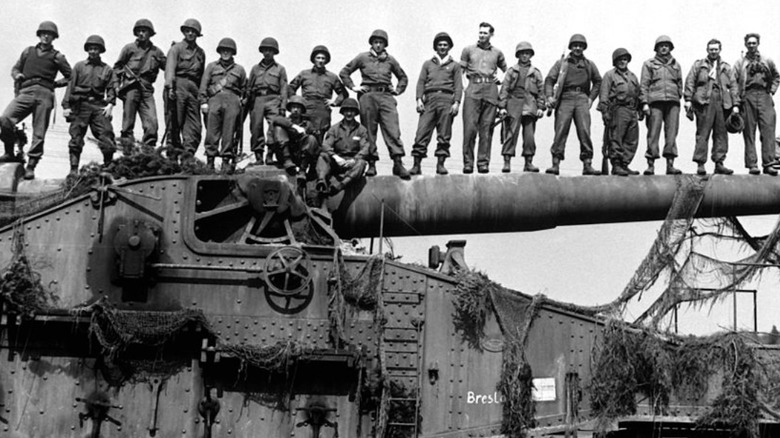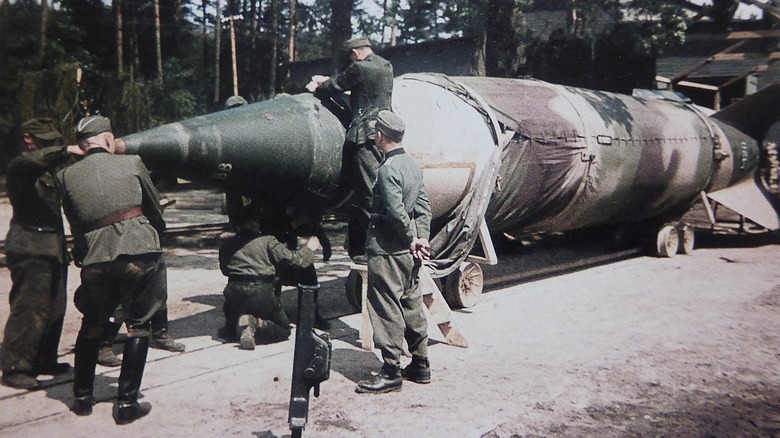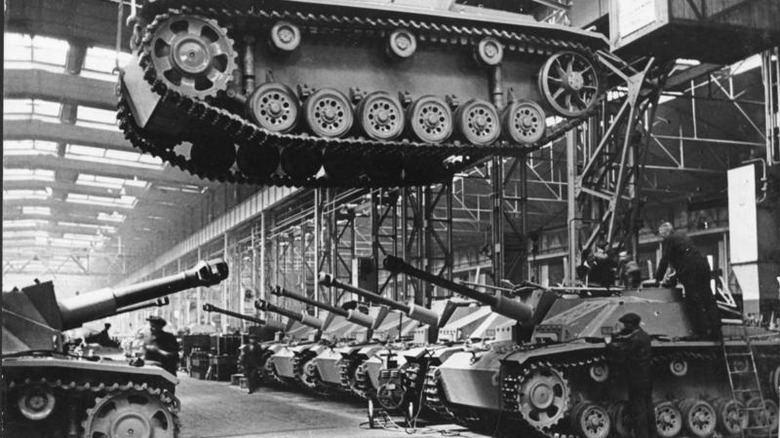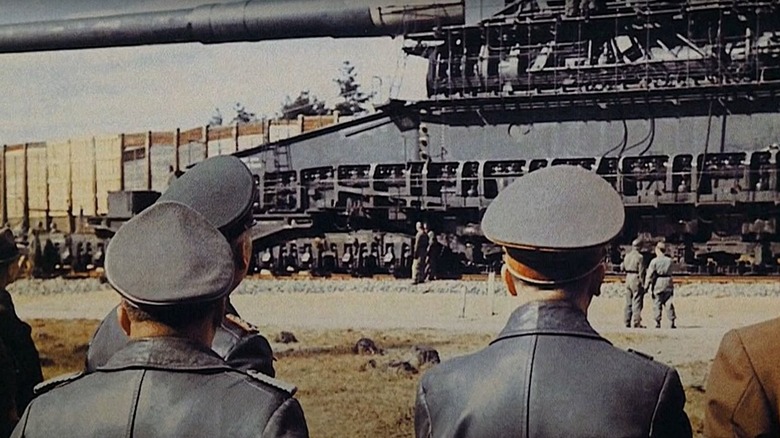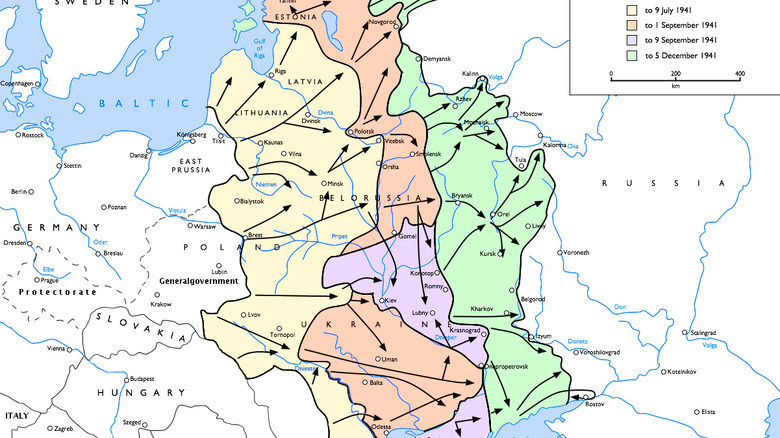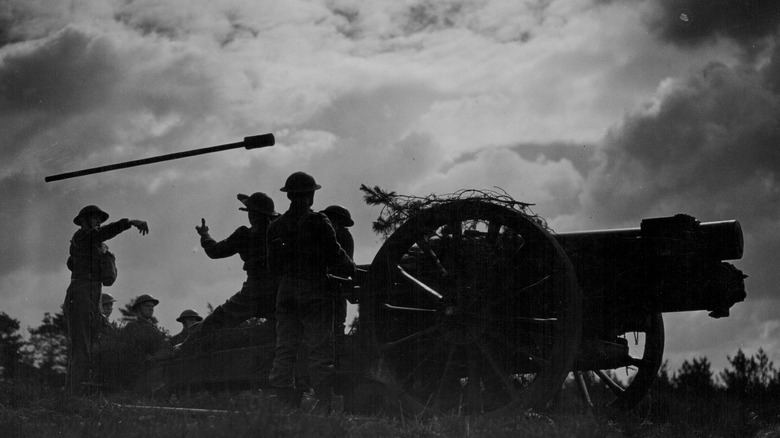Why Nazi Germany's Wonder Weapons Didn't Win The War
Nazi Germany is one of modernity's easiest short-hands for "evil, tromping, fascist empire." Need a bad guy in a film? Toss some Nazi fodder in there. Looking for a square-jawed hero above the moral reproach of necessary violent action? Call for Indiana Jones, Captain America, Brad Pitt in "Inglourious Basterds" — heck, even Christopher Plummer in the end of "The Sound of Music" when he tears that Nazi flag in half.
That meager sample reveals a lot about our preoccupation with the militaristic side of World War II, the side where problems can be solved with just the right amount of punching or shooting (and singing: thanks, Julie Andrews). "Might = right," "right vs. wrong," big guns vs. bigger guns, villains who are easy to spot: This kind of absolute simplicity satisfies a deep human need to tribalize.
That being said, it's true that weapons-based technology has an enormous impact on the outcomes of armed conflicts. World War I saw an explosion of grim and horrible ways for folks to mutilate and torture each other, as Mental Floss outlines: tanks, poison gas, flamethrowers, and more. Pre-industrial conflicts were greatly influenced by military equipment like suits of armor, as Warfare History Network points out. Much of the power of ancient Rome is often attributed to its shields, swords, ships, and so on, as World History discusses.
So how about those Nazis? They didn't develop any atomic bombs, thankfully. But they did try their hand at constructing Wunderwaffe — "Wonder Weapons" that would win the war.
Too fast on the draw
So what exactly is a "Wonder Weapon"? As the name implies, it's a weapon meant to inspire "shock and awe," so to speak, in the hearts and minds of opponents. World War II was a race to out-do the other side's human-killing devices.
To that end, WWII saw a number of technological firsts. As the Smithsonian Air National Air and Space Museum says, rocket fighters, jet fighters, cruise missiles, ballistic missiles all sprang up in the space of half a year, from spring to fall, 1944. Less than a year later, on May 7, 1945, Germany officially surrendered. Japan surrendered following the detonation of the atomic bombs Little Boy and Fat Man over Hiroshima (August 6) and Nagasaki (August 9), respectively, which incinerated over 210,000 total people (figures per the International Campaign to Abolish Nuclear Weapons, ICAN). In this way, nuclear weapons definitely won the "shock and awe" race, and outstripped the would-be "wonder" invoked by any German "Wonder Weapon."
But such civilization-breaking weaponry came late in the war. Common wisdom says that Germany was a bit too slow on the draw with their Wonder Weapons, or else they could've won. In reality, there was a mismatch between the ambitiousness of German weapons design and other technology needed to support those designs. Missiles like the V-2 (Vengeance Weapon Two) couldn't be shot down and left behind massive craters, but were inaccurate because of poor guidance systems. In effect, Germany wasn't too late; their researchers were too early.
The Achilles' Heel of economics
Tanks, planes, bombs, missiles, ammunition, fuel, rail lines to transport goods, weapons-making facilities: These all require tons of resources. We're talking raw materials to build every component, down to the nuts and bolts, the manpower to do so, and most importantly, the money to finance it all.
The National Socialist German Workers' (Nazi) Party came to power in the years leading up to World War II largely because of economic reasons. When Adolf Hitler became chancellor of Germany in 1933 during the final days of the Weimar Republic, unemployment was at 33%, as History Learning Site states. The aftermath of World War I, combined with the Great Depression (1929-1939), crippled the German economy to the point where folks accepted any and every savior. By 1939, the number of unemployed in Germany had fallen from 6 million to about 300,000. These numbers were fudged a bit (women were excluded, e.g.), but to many, the Nazi party was precisely what Germany needed.
However, Germany was never a resource-rich country. They struggled to maintain production during World War II, while Allies like England and France were fed by long-standing colonial supply lines. As We Are the Mighty outlines, Germany was always the underdog. In 1938 alone, the country consumed 44 million barrels of oil, but only produced 3.8 million barrels. And as the Third Reich raged, their imports dried out.
So all of Germany's imposing Wonder Weapons? There just wasn't enough materials to make them matter.
Too ambitious to be useful
As All That's Interesting depicts, many of Germany's Wonder Weapons were monstrously oversized, to the point of complete impracticality. They cost too much, and were too tough to produce. But as the Smithsonian Air National Air and Space Museum points out, this too was part of the Nazi vision, particularly that of Propaganda Minister Josef Goebbels. Wonder Weapons were designed to reflect the might of the Third Reich. They were propaganda tools meant to inspire confidence in allies as often as whispers of fear among enemies.
Take the Karl-Gerät siege mortar machine, nicknamed "Thor" after the Norse god (self-deification was another big facet of Nazi propaganda). It was "the size of a blue whale" with shells "the size of a rhinoceros." And of course, these overly-ambitious reflections of pride broke down all the time. They were too complex, too big, too clunky, and too slow. They were deployed in a couple of battles, like the Battle of the Bulge, but once the Allies destroyed them, no more were made.
Or behold the "Great Gustav" (above), a bonkers rail gun that stands as the largest such weapon ever created. It was 155 feet long, weighed 1,350 tons, and fired 11-foot shells weighing seven tons each. Like "Thor," it and its sister gun "Dora" saw limited action before the war ended.
Also on the list? The "heaviest tank ever built," the Panzer VIII Maus tank, an orbital "sun gun," and a "death ray" that fired unblockable x-rays.
Geographically and tactically overextended
Geography and questionable tactical choices also tanked (so to speak) the impact of German Wonder Weapons. Germany, a country landlocked on three sides, dispersed its armies in every single direction. Nazis struck west into France towards Spain, south through Yugoslavia and Hungary all the way to Greece, north into Denmark and Norway, and east into Poland and Russia. Quite simply, they were overextended. As History recollects, their push into Russia, which nobody expected, came back to bite them. Like Napoleon over a century before, Germany couldn't make it across Russia's vast, frozen expanse. This, plus renewed pushes in the West by Allies, led to Germany's surrender.
These are more general, tactical flaws in the German campaign, but the question remains: What real good would Wonder Weapons have made in this situation? What benefit would one or two more giant, clunky cannons actually have yielded? German's aforementioned, already poor resources were spread thinner and thinner across production and transportation lines extending deeper and deeper into occupied territory.
Heritage Daily, even judging only by pictures, displays a similar "spread too thin" Wonder Weapons problem; there were too many kinds. It's as though the Third Reich decided to research, design, manufacture, and deploy custom-built weapons and vehicles for each unique situation it came across. It's all impressive on the surface, but as students of history can tell you, it's the most widely applicable, most humble, most easily produced technology that often makes the biggest difference.
The true King of Battle
Finally, we can view the effectiveness and impact of Germany's Wonder Weapons through the lens of casualties. The National World War II Museum lists how many people died in World War II, both military and civilian. Numbers reach a staggering 70 million people dead over the war's six years, from 1939-1945. Russia suffered the worst, at 24 million dead, followed by China with 20 million. And Germany? It lost somewhere between 6.6 and 8.8 million total people, about 5.5 million of whom were soldiers. The population of Germany began the war with about 68 million, as Country Studies says. Comparatively, a higher percentage of the German population died than many other countries, and more of them were soldiers.
What does this mean in terms of Wonder Weapons? It means that Wonder Weapons weren't war-winners to begin with. Exotic weapons didn't make the difference; practical ones did. Practical weapons like ground-level, human-killing artillery. Artillery that, as the Army Historical Foundation describes, reached behind barricades and cleared paths for troops and vehicles to move forward and gobble up land. There's a reason why, as the Baltimore Sun says, artillery is called the "King of Battle." This also means that the atomic bombs dropped on Japan also didn't "win" World War II, either. And Germany's magic, insta-kill death rays? They never got made.
How many people did Germany's Wonder Weapons kill? What was their effectiveness? Negligible, aside from their psychological impact and the awe they engender in hindsight.
